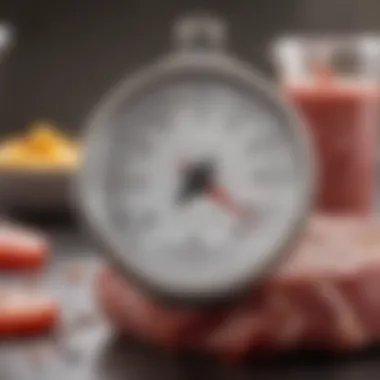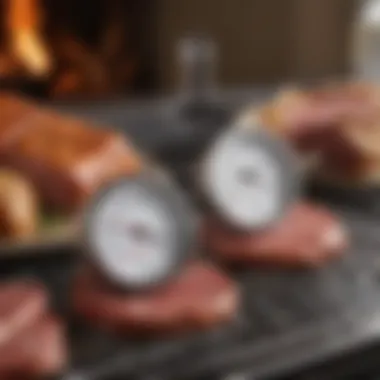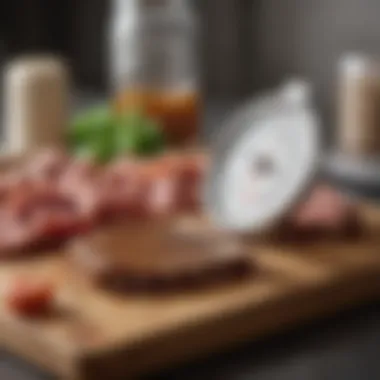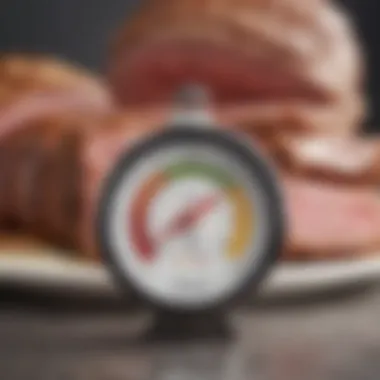Mastering Precision Cooking with Four Probe Thermometers


Intro
Meat thermometers are often seen as a simple tool, yet their importance in culinary practices cannot be overstated. In recent years, the four probe meat thermometer has emerged as a game changer in kitchens around the world. This article examines the benefits of utilizing a four probe meat thermometer for precision cooking.
As cooking methods evolve, so do the tools we use. The four probe design allows for multiple temperature readings at once, increasing efficiency and accuracy. Whether it’s slow roasting a pork loin or grilling the perfect steak, precise temperature measurements are crucial. This tool ensures that meats are cooked evenly and safely, minimizing the risk of undercooking or overcooking.
Furthermore, the article provides an overview of the technology behind these devices and their advantages compared to traditional thermometers. It also focuses on practical applications across various cooking methods, giving readers real-life scenarios where a four probe meat thermometer can shine. Proper maintenance is also essential; thus, tips for keeping the device in good working condition will be discussed throughout the text.
By the end of this exploration, culinary enthusiasts will have a clearer understanding of how to elevate their cooking practices. Utilizing a four probe meat thermometer not only enhances the flavor profiles of different meats but also promotes safety in kitchen procedures.
Prologue to Meat Thermometers
The relevance of meat thermometers in culinary practices cannot be overstated. They serve as critical tools, ensuring that meats are cooked to the right temperatures, enhancing flavor while maintaining safety. In this section, we will discuss the factors that make understanding meat thermometers vital for any cooking enthusiast.
Evolution of Cooking Thermometers
Cooking thermometers have evolved significantly from their rudimentary beginnings. Historically, cooks relied on their intuition and experience to gauge the doneness of meat. This was often inconsistent, leading to undercooked or overcooked dishes, which could result in foodborne illnesses. With the introduction of analog thermometers, measuring temperatures became more precise. These devices utilized metal probes and dial indicators.
The advancement did not stop at analog versions. The emergence of digital thermometers revolutionized the cooking experience. They offer quicker reading times and increased accuracy. As technology further advanced, the four probe meat thermometer came into play. This innovative design allows cooks to measure multiple meat temperatures at once, enhancing efficiency and precision in the kitchen.
Importance of Temperature Control in Cooking
Cooking meat to the correct temperature is crucial for both flavor and safety. The Maillard reaction, which gives browned food its distinct flavor and color, requires specific temperature conditions. If the meat is not cooked adequately, harmful bacteria can survive, posing health risks. According to the USDA, various types of meat require different internal temperatures to be considered safe.
Having precise control over temperature prevents the common pitfalls associated with cooking. Instead of relying on guesswork, cooks can ensure that meats are done just right. They can achieve desired textures and flavors without compromising food safety. Using a four probe thermometer maximizes this control, as it allows monitoring multiple sections of larger cuts of meat simultaneously, ensuring uniform cooking.
Understanding Four Probe Meat Thermometers
Four probe meat thermometers are an advanced tool in precision cooking. As the name suggests, they feature four probes that can simultaneously measure the internal temperature of different areas of meat. This feature is significant, as it allows for a more comprehensive understanding of the cooking process.
The importance of understanding four probe meat thermometers lies in their ability to optimize cooking for various types of meat. Traditional single-probe thermometers provide limited insight, often focusing on a single section. This can lead to overcooked or undercooked meat, where the central area might be at a different temperature than the outer layers. In contrast, a four probe thermometer can help detect temperature variances, ensuring that the entire cut of meat reaches the desired doneness uniformly.
With food safety becoming increasingly important, the use of these thermometers can greatly reduce the risks associated with undercooked meats. For culinary enthusiasts, knowing the exact cooking temperature improves flavor and texture, resulting in a more enjoyable dining experience.
What is a Four Probe Thermometer?
A four probe thermometer is a specialized cooking device designed to measure the internal temperatures of meat accurately. Each probe is inserted into different parts of the meat, allowing for multiple measurements at once. This is particularly useful for larger cuts of meats, like whole turkeys or roasts, where various sections may cook at different rates. Moreover, the device often comes equipped with digital displays, making it easier for cooks to read temperatures quickly.
Typically, probe thermometers come with features that allow for quick temperature readings, alarms to indicate when a desired temperature is reached, and even wireless connectivity for remote monitoring.
How Does It Work?
Understanding how a four probe meat thermometer works is essential for getting the best results when cooking. Each probe consists of a heat-sensitive sensor that detects the temperature in its immediate vicinity. When you insert a probe into the meat, it measures heat transfer, providing an accurate reading of that section's internal temperature.
The device continuously displays the readings from the four probes, allowing cooks to monitor the different sections' temperatures in real-time. Some devices may also feature an app or another interface to log and track cooking temperatures, facilitating better planning for meal preparation.
To maximize the effectiveness of a four probe thermometer, it is crucial to place the probes in strategic locations. Ideally, they should be positioned away from bones or large fat deposits, which can affect the accuracy of the readings. Overall, the simple operation of these devices, paired with their capacity to enhance precision in cooking, makes them indispensable for both professional chefs and home cooks alike.


Advantages of Using a Four Probe Thermometer
Using a four probe thermometer provides significant advantages for anyone engaged in precise cooking. These devices stand out from traditional thermometers through a combination of technology and practicality. The ability to monitor multiple points of temperature simultaneously is crucial for achieving optimal cooking results across various meats. Understanding these benefits helps culinary enthusiasts improve their cooking methods and enhance the safety of food preparation.
Simultaneous Temperature Monitoring
One of the most evident advantages of a four probe thermometer is the capability for simultaneous temperature monitoring. This feature allows cooks to check the temperature of multiple cuts or areas of the meat at once. For instance, when grilling a whole chicken, measuring the temperature of the breast and thighs can ensure even cooking. Traditional thermometers typically limit the user to a single reading, which often leads to overcooking some parts while undercooking others.
"A four probe thermometer eliminates guesswork in cooking."
Being able to have readings from four different probes means cooks can adjust cooking times and temperatures accordingly. This ultimately leads to better flavor and texture. Moreover, this feature is particularly useful in cases where larger or thicker cuts of meat are involved. It saves time and effort, allowing for a more efficient cooking process, especially in busy kitchen environments.
Improved Cooking Precision
Precision in cooking is vital for many culinary processes. A four probe meat thermometer enhances this precision in several ways. First, it provides accurate readings that reflect the internal temperature at various points in the meat. For example, knowing the exact temperature of the center as well as the outer layers helps prevent common issues such as dryness or chewiness.
Additionally, different meats have varying optimal cooking temperatures to achieve the desired doneness. A four probe thermometer allows for immediate adjustments based on real-time data, enabling cooks to hit these targets more consistently. This level of control is uncommon with single probe units and can significantly improve overall cooking outcomes.
Enhanced Food Safety
Food safety is an essential aspect of cooking, and a four probe thermometer helps enhance this through precise monitoring. Cooking meat to the appropriate internal temperature is critical for eliminating harmful bacteria. Each type of meat, such as chicken, beef, and pork, has its own safe cooking temperature. The ability to monitor these temperatures diligently reduces the risk of foodborne illnesses.
In practical terms, the four probes can simultaneously track different meats in a multi-course meal. Cooks can ensure that all proteins reach their safe cooking temperatures without needing to remove other items from the heat. This multitasking ability not only simplifies meal preparation but also promotes better food safety practices in the kitchen.
Application in Different Cooking Methods
The diverse application of a four probe meat thermometer is crucial when it comes to achieving desired culinary results across various cooking methods. Each cooking technique presents unique challenges and requires distinct approaches to temperature management. Utilizing a four probe thermometer allows culinary enthusiasts to monitor multiple areas of a dish simultaneously, ensuring that meats cook evenly while meeting safety standards. This not only enhances flavor and texture but also promotes food safety by reducing the risk of undercooked meat.
Grilling and Barbecuing
Grilling and barbecuing are beloved cooking methods that bring a distinct flavor to meats. However, achieving a perfectly grilled steak or barbecued chicken requires precise temperature monitoring. A four probe meat thermometer allows users to check different sections of the meat at once. This is particularly helpful when cooking thicker cuts or when using the two-zone technique on the grill, where one area is for direct heat and another for indirect cooking.
- Key Benefits:
- Simultaneous Monitoring: Accurately track internal temperatures across multiple meats.
- Avoid Overcooking: Helps prevent the common issue of burnt exteriors with undercooked interiors.
- Flavor Retention: Ensures meats are cooked to the ideal doneness, enhancing taste.
This method also allows for experimentation with marinades and rubs, making sure the flavors are sealed in while getting the right doneness.
Roasting and Baking
Roasting and baking techniques benefit significantly from the use of a four probe thermometer. Whether it is a holiday turkey or a layered cake, accurate temperature control is vital. With a four probe thermometer, the cook can monitor different areas of a large roast, which ensures that it cooks evenly. The advantage here is clear: no more guesswork or uneven cooking.
- Considerations:
- Heat Distribution: Allows for understanding how heat travels throughout the dish.
- Safety Measures: Ensures that poultry and large meats reach safe internal temperatures.
- Timing Optimization: Helps determine cooking times accurately.
Knowing when to take a roast out of the oven, based on real-time temperature readings, leads to more successful meals.


Sous Vide Cooking
Sous vide is a modern cooking technique that locks in flavors and moisture by cooking food at precise temperatures in a water bath. A four probe thermometer enhances this method by allowing cooks to monitor the temperature of the water and the food simultaneously. This precision ensures that proteins retain moisture while achieving the desired level of doneness without overcooking.
- Advantages:
- Precision Cooking: Achieve exact temperature settings for delicate proteins.
- Enhanced Consistency: Provides uniform results across multiple dishes or portions.
- Safety Assurance: Keeps meats at safe temperatures during extended cooking times.
Using a four probe thermometer in sous vide not only streamlines the cooking process but also raises the standard of what can be achieved in home kitchens.
With a four probe meat thermometer, cooks at any skill level can elevate their culinary techniques and ensure food safety.
Through these detailed approaches in different cooking methods, the four probe meat thermometer proves to be an invaluable tool for anyone keen on perfecting their culinary skills.
Choosing the Right Four Probe Thermometer
Choosing the correct four probe meat thermometer is a significant decision for anyone serious about cooking. This instrument is not only about achieving the right temperature but also about enhancing the overall cooking experience. A suitable thermometer leads to better results and, ultimately, more enjoyable meals. When selecting, it is crucial to consider various elements that impact performance and usability.
The right meat thermometer allows for multiple readings at once, ensuring that different parts of the meat achieve optimal cooking temperatures without overcooking. This attribute can save time and provide a sense of control in the kitchen. Understanding the specific features of each model is essential.
Key Features to Consider
When evaluating a four probe meat thermometer, several key features should guide your decision-making process:
- Probe Length: Longer probes reach deeper into meat, making them suitable for larger cuts. Determine the ideal length based on your common cooking practices.
- Temperature Range: Ensure that the thermometer can measure a wide range of temperatures. Some cooking methods require very high temperatures, while delicate meats need lower ranges.
- Response Time: A quick response time provides immediate readings, which is vital for adjusting cooking conditions promptly.
- Display Quality: Choose a model with a clear, easy-to-read display. Digital screens with backlit options can be beneficial for outdoor cooking in low light.
- Durability: Look for sturdy materials to withstand regular use. Stainless steel probes tend to be more resilient than those made of plastic.
"A quality thermometer is an investment in your cooking precision. Prioritize features that align with your cooking style, and your meals will thank you for it."
Price Range and Quality
The price of a four probe meat thermometer can vary significantly based on features and brand. Budget-friendly options are available, but often, they may lack the accuracy or durability needed for consistent results.
- Entry-Level Models: These often range from $20 to $50. Suitable for hobby cooks but may have limited functionalities.
- Mid-Range Options: Priced between $50 and $100, these models usually offer better precision and durability. They may include features like wireless connectivity.
- High-End Devices: Prices for premium thermometers can exceed $100. These devices often come with advanced technology, such as app connectivity for temperature tracking.
Quality is paramount in this investment. Examine user reviews and brand reputation before committing.
Elevate your cooking insights by making an informed choice about your four probe meat thermometer. The right selection will lead to enhanced precision and consistently satisfying results in your culinary pursuits.
Best Practices for Using a Four Probe Meat Thermometer
Understanding best practices in using a four probe meat thermometer is a vital part of achieving precision in cooking. Proper utilization of this tool can enhance flavor and ensure food safety. This section will discuss key elements such as probe placement, how temperature zones function, and the significance of knowing optimal cooking temperatures. The goal here is to empower culinary enthusiasts with the knowledge needed to make the most of their thermometers during cooking.
Placement of Probes
Correct placement of the probes is crucial for accurate temperature readings. Each probe should be inserted into the thickest part of the meat, avoiding any bones or fatty areas. This is important because fatty tissues and bones can give misleading readings. For example, when cooking a whole chicken, place one probe in the breast and another in the thigh. This approach ensures that both the fastest and slowest cooking parts of the meat reach the desired temperatures. Additionally, when using multiple probes, track the temperatures of different cuts of meat simultaneously. This technique can provide a comprehensive view of cooking progress across various meats.
Understanding Temperature Zones


Knowing the temperature zones of different types of meat is essential for ensuring they are cooked properly. Each variety has its own safe cooking temperature and ranges for doneness, which can vary based on the cut. For example:
- Beef: Rare - 120°F (49°C), Medium - 140°F (60°C), Well-done - 160°F (71°C)
- Poultry: Safe minimum temperature - 165°F (74°C)
- Pork: Safe minimum - 145°F (63°C)
By inserting probes into the specified areas of meat, users can accurately assess when each type has reached its safe cooking zone. Utilizing multiple probes allows for watching different zones simultaneously and provides a better oversight of cooking efficacy. This is particularly useful in grilling, baking, or roasting.
Learning Optimal Cooking Temperatures
Familiarity with optimal cooking temperatures is fundamental in culinary practices. Every meat type has recommended temperature guidelines that enhance flavor, texture, and safety. For instance, lamb should be primarily cooked to about 145°F (63°C) for medium-rare. Knowing these numbers can turn cooking from a chore into a skillful endeavor. Here are some considerations:
- Always allow some rest time after cooking, as temperatures continue to rise slightly.
- Remember that the USDA provides guidelines which can be referenced for different meats.
- Use the thermometer’s readout, adjusting the cooking as necessary based on the data it provides.
"Knowledge about cooking temperatures is what turns a good dish into a memorable one."
These best practices ensure that the four probe thermometer serves not just as a tool, but as a partner in your culinary journey. An understanding of probe placement, temperature zones, and cooking temperatures can greatly enhance your cooking accuracy and safety. Utilizing these principles leads to well-cooked, safe, and flavorful meals.
Maintenance and Care of Four Probe Thermometers
Proper maintenance and care of four probe thermometers is crucial for ensuring accurate readings and longevity of the device. Just as a chef meticulously prepares ingredients, maintaining your thermometer can enhance its effectiveness over time. A neglected thermometer can lead to incorrect temperature readings, resulting in improperly cooked meat. This section discusses essential practices for maintaining and caring for your four probe thermometer to secure its optimal performance.
Cleaning Processes
Keeping your four probe meat thermometer clean is essential for food safety and measurement accuracy. Food residues can lead to contamination and skewed readings. Here are some steps to follow for effective cleaning:
- Use Mild Soap: After each use, wash the probes with warm water and mild soap. Avoid abrasives or harsh chemicals as they can damage the surface.
- Wipe Down the Body: The thermometer's exterior should be wiped with a damp cloth to remove any splatter or dirt.
- Disinfect the Probes: For extra safety, you may also want to disinfect the probes using a solution of equal parts water and vinegar. This will help eliminate bacteria without harsh chemicals.
- Avoid Submerging in Water: Make sure not to submerge the entire thermometer in water, especially if it contains electronic components.
By following these steps, you can keep your thermometer in top condition, ensuring high accuracy in your cooking endeavors.
Calibration Techniques
Calibration is another critical aspect to maintaining your four probe meat thermometer's reliability. Over time, temperature readings may drift, leading to inaccuracies. Here are some strategies for calibrating your thermometer:
- Ice Water Method: Fill a container with ice and water, ensuring it is a slushy mixture. Insert the probe into the mixture. The thermometer should read 32°F (0°C). If it does not, adjust according to the manufacturer's instructions.
- Boiling Water Method: Boil water in a pot. Insert the probe into the boiling water. The thermometer should register 212°F (100°C) at sea level. Make adjustments if necessary.
- Follow Manufacturer Guidelines: Different models may have unique calibration processes. Always refer to the manufacturer's manual for specific instructions on how to calibrate your thermometer properly.
Regular calibration can extend the life of your thermometer and guarantee that your cooking remains precise, helping you achieve the best possible results.
By performing these maintenance tasks diligently, users can ensure that their four probe meat thermometer remains a reliable tool in the kitchen. Such practices not only promote accuracy but also preserve the integrity of the device, making it a long-lasting ally in the pursuit of culinary excellence.
Closure and Future of Cooking with Technology
The domain of cooking is undergoing a significant transformation thanks to technology. The emergence of devices like the four probe meat thermometer highlights the integration of precision measurement tools into the culinary process. This conclusion underscores how these advancements are reshaping the way we think about cooking, with a clear emphasis on accuracy, flavor enhancement, and food safety.
As culinary techniques evolve, the importance of understanding and applying modern tools cannot be overstated. Four probe thermometers offer multiple advantages that cater to diverse cooking styles. They allow chefs and home cooks to monitor doneness across various meats simultaneously. This not only optimizes cooking time but also reduces the chances of undercooked or overcooked dishes.
The Rise of Smart Cooking Devices
Smart cooking devices are transforming traditional kitchens into technology-enabled zones. The rise of smart thermometers, including models with multiple probes, is notable. These devices connect to smartphones via apps, allowing users to check temperatures remotely. This convenience enables more efficient multitasking in the kitchen.
The integration of artificial intelligence in these devices is also significant. Some thermometers can suggest cooking times and techniques based on the type of meat and its weight, providing tailored advice. Consequently, both novice and experienced cooks can enhance their culinary skills.
Final Thoughts on Four Probe Thermometers
Investing in such technology is a practical step towards achieving culinary aspirations. As cooking technology continues to advance, tools like the four probe thermometer will likely become standard in kitchens.
By embracing these innovations, culinary enthusiasts can expect to enhance both their skills and the dining experience they provide.







